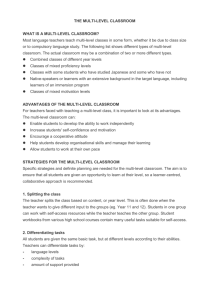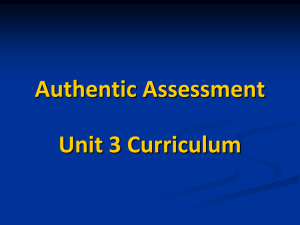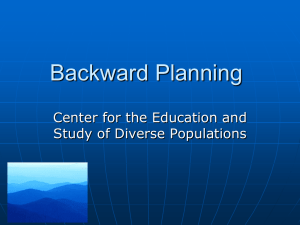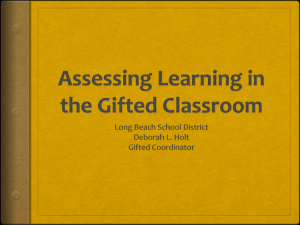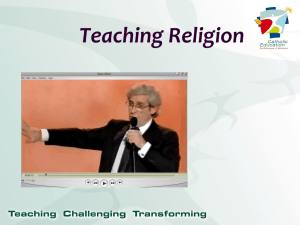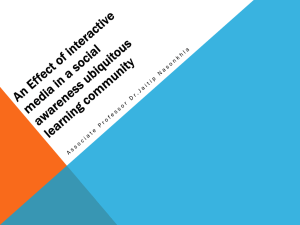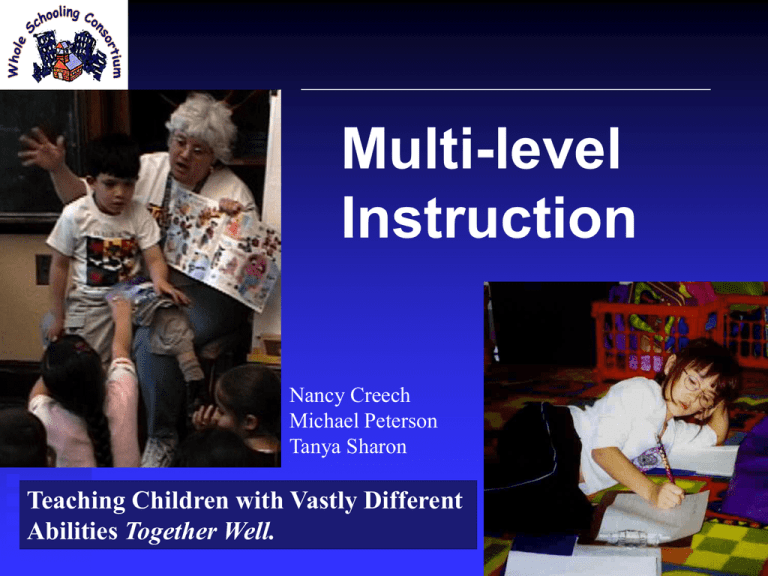
Multi-level
Instruction
Nancy Creech
Michael Peterson
Tanya Sharon
Teaching Children with Vastly Different
Abilities Together Well.
Why Multi-level
Instruction?
One level instruction
doesn’t work -- 3-7 grade levels
in every class.
Welcoming segregated
students back to our classes as
inclusive teachers
Building on and expanding
whole language theory and
practice
Building political alliances
in an uncertain time
MANAGING DIFFERING
ABILITY LEVELS in CLASSROOMS
• One size fits all <-> Segregation
• Stable ability group
• Pull out / pull aside -- at the
side or back of the class.
• Adapting curriculum. Individual
adaptations of teaching approach or
modification of expectations.
Best
• Differentiated instruction.
• Multi-level teaching
Learning activities allow children at
different levels to learn together.
What is . . .
Authentic Multi-level Instruction
Students of very different
abilities levels
Learn at their own level of
challenge
With support and guidance
Through authentic learning
activities
In heterogeneous groups
Without stable ability
grouping
PRINCIPLES OF AUTHENTIC,
MULTI-LEVEL INSTRUCTION
1.
2.
3.
4.
5.
Authentic learning.
Multiple levels.
Scaffolding.
Higher order thinking.
Inclusive,
heterogeneous
grouping.
6. Integrated skill
learning.
7. Focus on meaning and
function.
8.
9.
10.
11.
12.
13.
14.
Multi-modal.
Building on the
strengths of children.
Fostering respect.
Student interests,
choices, power, and
voice.
Collaborative learning.
Reflection.
Growth and effortbased evaluation.
GROUPING
IN A MULTI-LEVEL CLASSROOM
Heterogeneous, inclusive grouping
Interests, friendships, self-selected
‘just right’ work
Ability grouping -- coping with the
dangers
No ongoing, stable ability groups
Specific short-term skill needs -- minilessons
Vary compositions often, daily
Based on choice of children (shifting power)
Strategies for
Authentic Multi-level Instruction
1. Individual learning activities with materials, resources,
and expected output at different levels of ability
Personal best and ‘just right’ work
Individual student goals
Reading and writing workshop.
Individualized spelling lists.
Partner reading / writing
Authentic homework projects – eg.
project on the hero of a family
member.
Publishing student work
Personal museums
Strategies for
Authentic Multi-level Instruction
2. Projects and activities that allow roles at differing levels of
complexity and ability
Thematic unit
Workshop projects linking literacy,
science, math, social studies – eg.
studying local community – writing,
interviewing, building model of historical
community, making play.
Dramatic play of reading / writing
Whole class learning project – eg.
class hatching chickens, studying and
discussing their behavior, taking roles in their
care.
Collaborative exploration of topic
of study.
Strategies for
Authentic Multi-level Instruction
3. Whole group activities that allow processing &
understanding with needed scaffolding at differing ability levels
Morning meeting
& message
Read aloud
Choral reading
Sharing chair
Strategies for
Authentic Multi-level Instruction
4. Structures that provide for specific skill
development without stable ability grouping.
Comprehension aids
– story maps, webs, etc.
Student experts
Mini-lessons
Student conferences
Strategies for
Authentic Multi-level Instruction
5. Technology that expands the capacity of all learners.
Internet.
Graphics, word processors, more.
Talking software.
Voice command writing.
Communication devices.
Adapted computer input and output.
Specialized switches.
And more.
A living laboratory on the interaction
of technology and human capability.
Strategies for
Authentic Multi-level Instruction
6. Assessment and evaluation that centers on teaching and
learning.
Competency assessments observations,
performance and work sample assessments
Portfolios
Self-assessment
Publishing student work
Student-led conferences
Multi-modal demonstrations of learning –
story, illustration, skit, song, poem, etc.
Focus on effort, goals, growth
AUTHENTIC
MULTI-LEVEL
INSTRUCTION
Bringing excellence & equity,
Ethnic and disability diversity,
Academic learning & community
. . . Together.
Instruction &
Grouping
MEANING focus with
skills imbedded
Morning message
Literacy centers
Reading & writing
workshop.
Word and sound minilessons.
Conferencing.
Student-led conferences.
SKILLS / FACTS focus
Direct instruction -phonemic awareness &
phonics.
Fill in blank worksheets.
Lecture, text, multiple
choice tests
Heterogeneous - Ability
Grouping
DESIGNING INSTRUCTION FOR
DIVERSE LEARNERS
1. Design Teaching for
Diverse Learners
2. Adapt &And Modify
Teaching
3. Evaluate and Revise
Teaching
DESIGN FOR
DIVERSITY
ADAPT
EVALUATE &
REVISE
ACADEMIC
SOCIALEMO TIONAL
PHYS ICAL
Cognitive growth and
development
Relationships,
Community, & Behavioral
Challenges
The Learning
Environment
Authentic instruction
Project learning
Micro-society
Multiple intelligences
Multi-level Lessons
Build community
Promote caring
Encourage friendships.
Teach social skills and
Òemotional
intelligenceÓ
Advanced projects
Reduce diffi culty.
Use drama to teach
social studies.
Provide additional help
and support.
Read stories to students
with reading
difficulties.
Read stories to all
students.
Incorporate drama and
art in all subjects.
Identify interests.
Understand needs &
communication.
Provide positive
alternatives.
Peer support.
Circles of f riends.
Heterogeneous
grouping.
Space for wheelchairs
Use multiple learning
modalities
Authentic teaching
space designed for.
Talking computer for a
blind student.
Rearrange books so
student in wheelchair
can reach them.
Spaces to choose to be
alone or get help
Use circles of f riends to
build community.
Use talking computers
for all students.
Mul tiple Levels O f Learning Goals and Activiti es
Exampl e from ÒGoin g to the Ex trem esÓ Ğ Ja
son Project
Learning Goals
Learn . . .
Multi-level roles in the learning
activity. Do . . .
Level 3.
Teamwork and leadership skills
Measurement
Methods to record multiple data
Compare results of data from two
diffe rent sources
Develop an analysis report.
Level 3.
Leadership in organizing the team and solving
problems.
Recording data.
Helping the team t o compare their results with
the scientist.
Writing an analysis report.
Level 2.
Learn how to work as a team,
plant seeds,
record growth, and
write simple conclusions.
Level 2.
P lant seeds
Record plant growth
Describe conclusions in journal.
Level 1.
Help set up materials,
work in a team, and
do basic recording of the responses of
the plant.
Level 1.
Help set up materials.
Draw picture of plant each day.
Strategies For
Multi -Le ve
l Te achin gTeaching
Examples
of Authentic
Multi-level
LITE RACY
SCIEN CE
MATH
SOCIAL
S TUDIES
Choice of books
at different levels.
Experiments with
different group roles
identified.
Math games
Projects that allow
students different
roles.
Buddy reading.
Read-alouds.
Individual writing
goals.
Stick-figure
drawing to write
a story line
Individual spelling
lists.
Note-taking by
graphic organizers
like webbing
Informational
reading at many
levels.
Heterogeneous work
groups help each
other with
assignm ents
Writing poetry
Art to convey meaning.
Choice of inquiry project at differing
ability levels.
Partial participation in learning
activities.
Cooperative learning groups (with
differing levels of activities to
contribute to the total group).
Learning groups
based on student
interest and
readiness.
Dramatic role-play of
social and historical
situations.
Math proj ects with
multiple types of
tasks and levels to
choose from .
Write songs, poem s,
stories, etc. that show
learning.
Whole class interest
related com munity
projects.
Involve local people
with interviews,
visits, and projects.
Heterogeneous
practice groups
Support and scaffolding to provide
assistance in com pleting activities
not possible independently.
Student-led portfolio conferences.
Pair-Share information
Heterogeneous partners for proj ects.
Students choose own topics within
broader theme
TEACHING STRATEGIES
For Authentic Multi-level Teaching
1.
2.
3.
4.
5.
6.
Integrative, thematic
units.
Classroom workshop.
Authentic learning
experiences.
Small group activities.
Representing to learn
Reflective assessment.
EVALUATION & ASSESSMENT
Rubrics
Competency-based
assessment
Student self and peer
assessment
Student-led
conferences
Grading: Effort and
growth
Building Community to Learn
Morning greeting and meeting
Classroom meetings
Student experts
Jobs for all
Mini-lessons
Collaborative learning
Peer buddies
Circle of friends
Community building games
Teach and model respect for
differences
Whole Schooling
FIVE PRINCIPLES for School Renewal
Empower citizens in a democracy
Include all: all children learn in regular classes
together across culture, ethnicity, language, ability,
sex, & age.
Authentic, multi-level instruction:
teach connected to real, meaningful activities at
multiple levels of ability.
Build community & support
learning:
build community and mutual
support in the classroom and school.
Use specialized resources (special education, Title
I) to support students, parents, and teachers.
Partner: build real collaboration within the school
and with families & community
Macarthur Elementary

